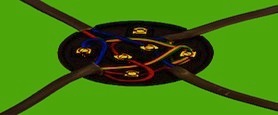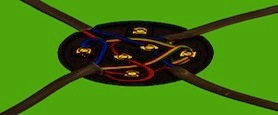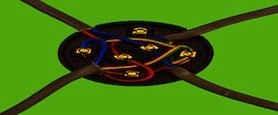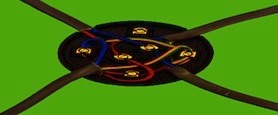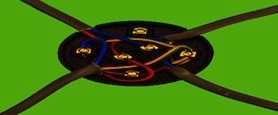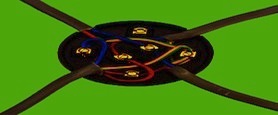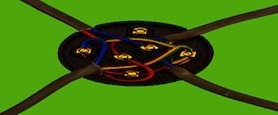Junction Box will be mainly prose-based. The idea is a determinedly simple one: to invite carefully chosen poets, writers and artists to write about whatever they want to write about. The subject matter is entirely open: it may be personal, political, literary, artistic, cosmological, or indeterminate or decisively subject-free: there are no boundaries. It's a space, hopefully, where practitioners will feel licenced to explore any aspect of their experiences as human beings, from any angle available to them. No attempt to try and define here what prose is, considering that the enclosures already overlap, grain spills from the granaries, smells are constantly drifting in from over the horizon. Approximately speaking, though, it's evident that many writers and artists feel the need, from time...
Issue 1
An Irregular Magazine More about Junction Box
There is a house in my head There is a house in my head. Not a whole house, but parts of a house, aspects of a house. The house and its surroundings go in and out of focus as I look. There are no missing rooms, or rooms that are locked and unable to be entered. Instead when I look, there are big unknowable holes between the fabric of one room and the next. Gaps and emptiness. When that happens, like when I wonder where the fridge is, I can see myself: black backdrop, travelling slowly through a motorised-shutter blurring long-jump leap across from one known point to another. A point of view that hangs in space as it waits for the room to catch up. It’s better outside. The grass is an acre, I reassure myself of that, and there are plans that tell me so. But the hills beyond the boundary...
a tracking essay by the fictional Belgian poet René Van Valckenborch Glance Flicks: Blu Ray Henri 2010 (Amsterdam-Bruxelles-Paris) Thingly 1969, 9 mins, b&w, sound, triple-screen, super 8 Utilising his trademark pie-chart circular triptych screen for only the third time, Coppens’ Thingly focuses upon a series of objects – scissors, contraceptive device, spectacles, paperweight, etc – so that their banality is rendered strange by close-up, discoloration (accomplished by direct dyeing of the film stock), as well as by the disconcerting irregularity of shot length. Uses multiple exposures to imaginative effect. The soundtrack consists of the objects directly contacting the microphone with all the inherent distortion this creates. Masks and Other Masks 1972, 26 mins,...
Mike was a quiet man who kept himself to himself. He was always asking for fresh clay for his pottery work, and could get on the teacher’s nerves. And then there was the Friday evening carrying of cardboard boxes, marked fragile, to reception so they could be shipped off to Ireland. Inside the boxes were brightly-coloured, highly-glazed, houses, 3-inch figures of men, women and children, and other objects, crafted meticulously day after day in the prison pottery class. Mike didn’t say much, but if persuaded he would launch into stories of dogs and cats, of poaching and performing wonders. He would bend and swoop as he warmed to his tale, and his traveller accent was loaded with emphases and intimacies, shifting in pace and volume. I asked him if he could write some down and he did. I...
It is a bank holiday and I get to write. I think so much about any future point where I might get time, that it drains away in the clearing of it. The question posed was: what I am thinking and working on just now, these days before coming to Hay. What is central to my practice, thinking. Just now. How I do thought these days, rather than having time to think, is a question. Something about the loss of duration, understood as a form of knowing in time, patience. But also discovering another kind of rewiring or pace. How practice begins to demand other routes, where thinking ceases to work along accustomed lines. How age shifts things along, and you come out elsewhere than you imagined. The headline in the paper this morning says we have gone past carbon emissions targets to the point of...
Anselm Kiefer's installation at White Cube. 11th March - 9th April 2011 "Engagement and reservation with Anselm Kiefer's recent installation at the Hoxton White Cube raises matters that I want to revisit or bring to the fore. DES MEERES UND DER LIEBE WELLEN [The Waves of Sea and Love] is the installation title and the name given to the main displays." "I start with a description of the installation, the title and the theme. A preliminary discussion of Kiefer's use of Euclidean diagrams follows. I then elaborate on the description of the main displays and potentials for meaning. This leads to a brief discussion of the use of more than one media and the use of vitrines. The article then branches into a deeper consideration of the use of geometry and drawing as modes of thought. The installation...
Hazel Eardley-Wilmot: a search for origins I first became interested in Hazel Eardley-Wilmot when I came across Ancient Exmoor in Minehead public library. I was intrigued by her description of the Neolithic stones on Exmoor, especially the unique ‘stone settings’ in their extraordinary geometric patterns: ‘Quite different from either the long rows or the circles are the small stone settings, Exmoor’s special puzzle. Nearly thirty are known, but none are understood’. However, as I continued my research, I realised that I was attracted as much by the quality of Eardley-Wilmot’s writing as by the subject matter. There are other books on the archaeology of Exmoor, and some more professional and scientific, but none were as well written as hers in terms of literary style,...
Hephaestus was and is the engineer of the gods – no one has replaced him as far as I know – the International Space Station, possibly the most complex artefact humanity has made is, as far as I can tell, not an act of hubris but more and more an act of humility. But let us return to The Smith, or Vulcan as he was also known. Hephaestus made things, simple objects, compound objects, intricate and complex objects. The other gods just seemed to find objects lying around – a sickle here, coins there; either that or they used crafted artefacts much closer to nature – clothing, winged sandals – a combination of leather and feathers. True, Hermes made a musical instrument – a lyre from tortoise shell and sinew but it was entirely organic. Hephaestus it was and is who transforms...
Email from Maggie O'Sullivan in response to a request from the editor for a contribution, Wed 18th May 2011: "I attach to this email a new, unpublished two-page piece in the hope it might be of interest: it's not really prose, so okay if it doesn't fit." For over thirty years, Maggie O’Sullivan’s work has appeared extensively in journals and anthologies (including Poems for the Millennium, Volume 2) and she has performed her work, often in collaboration, internationally. She is the editor of out of everywhere: an anthology of contemporary linguistically innovative poetry by women in NorthAmerica and the UK (1996). Recent publications include Body of Work (2006), WATERFALLS (2009) and ALTO (2009). murmur is due 2011 from Veer, as is The Salt Companion to Maggie O’Sullivan. Her...

